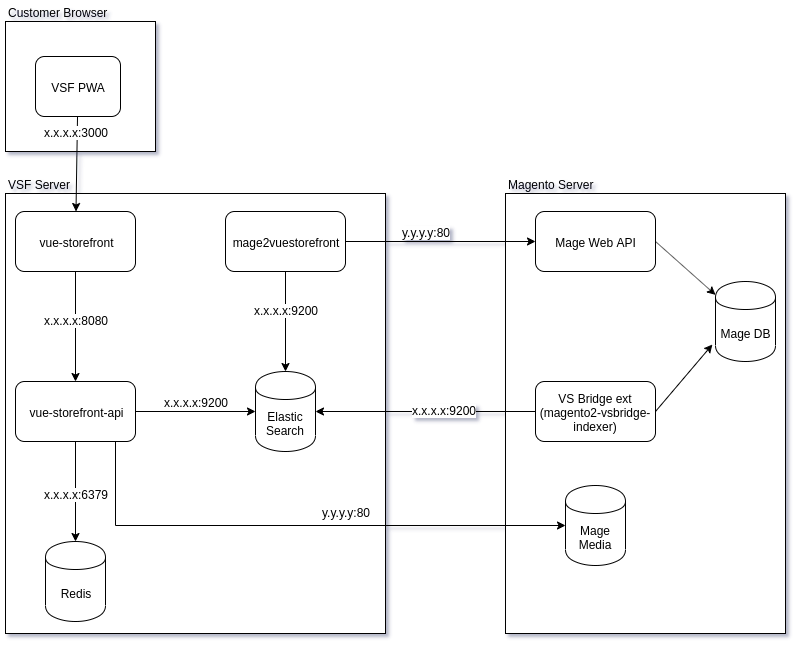Finally, I was able to see the data from Magento (categories and products) in the Vue Storefront (VSF) application. This is already the fourth article ( 1 , 2 , 3 ), in which I describe the process of exploring the possibilities of integrating VSF with an Magento 2-based electronic store, and the first where the data from Magento skipped to the customer’s browser.

Under the cat is a link to deployment scripts and a brief description of the steps.
purpose
Display in the client part the category / product data obtained from Magento.
Schematic
Now the dependencies between the application components are presented to me like this:

Work environment
In the current iteration, I again used the medium version of the Linux Ubuntu 18.04 LTS 64-bit server (2x 2198 MHz CPU, 4 GB RAM, 10 GB disk) in the Exoscale cloud.
Deployment scripts
I put the scripts for deploying application components into a separate project: flancer64 / vsf_mage2_setup .
Deployment Steps:
- Updating an empty OS, installing additional services and applications (Elasticsearch, Redis, yarn, ...) .
-
vue-storefront
. -
vue-storefront-api
. -
mage2vuestorefront
. - Start data replication from Magento 2 to VSF .
Deployment Configuration
At the time of this writing, the deployment configuration looks like this:
#!/usr/bin/env bash # ========================================================================= # Local configuration template. # Copy this file to `./cfg.local.sh`. # ========================================================================= export HOST_VSF="255.255.255.255" # ip address or domain name for VSF host (VSF Front/API, Elasticsearch & Redis) export HOST_MAGE="mage2.host.com" # ip address or domain name for Magento 2 host # address of REST API of source Magento instance export URL_MAGE_REST="http://${HOST_MAGE}/rest" export URL_MAGE_IMG="http://${HOST_MAGE}/media/catalog/product" export INDEX_NAME="vue_storefront_catalog" # Magento integration options # see: "How to integrate Magento2 with your local instance?" # at: https://medium.com/the-vue-storefront-journal/vue-storefront-how-to-install-and-integrate-with-magento2-227767dd65b2 export MAGE_CONSUMER_KEY="..." export MAGE_CONSUMER_SECRET="..." export MAGE_ACCESS_TOKEN="..." export MAGE_ACCESS_TOKEN_SECRET="..." export MAGE_CURRENCY_CODE="..."
Application Deployment
I clone the scripts for deploying the components on a clean host and set the local deployment configuration:
$ cd ~ $ git clone https://github.com/flancer64/vsf_mage2_setup.git $ cd vsf_mage2_setup/ $ cp cfg.init.sh cfg.local.sh $ nano cfg.local.sh ...
After that I execute the deployment scripts, from the first to the fourth:
$ cd ~/vsf_mage2_setup/ $ bash ./bin/step01_env.sh $ bash ./bin/step02_vsf_front.sh $ bash ./bin/step03_vsf_api.sh $ bash ./bin/step04_mage2vsf.sh
The contents of the scripts can be viewed on github'e. As a result, the following components will be installed and configured on an empty host:
- Elasticsearch
- Redis
- vue-storefront
- vue-storefront-api
- mage2vuestorefront
Component configurations can be seen in the appropriate deployment scripts.
Magento2 Data Replication Script => VSF
In the fourth step, a data replication script ~/mage2vuestorefront/src/run.sh
. I give it in its entirety (with the exception of sensitive data):
#!/usr/bin/env/bash # Exit immediately if a command exits with a non-zero status. set -e ROOT=$(cd "$(dirname "$0")/" && pwd) export TIME_TO_EXIT="2000" # Setup connection to Magento export MAGENTO_CONSUMER_KEY="87...20l" export MAGENTO_CONSUMER_SECRET="7f...95x" export MAGENTO_ACCESS_TOKEN="ox...lq3" export MAGENTO_ACCESS_TOKEN_SECRET="5d...6o0" # Setup default store export MAGENTO_URL="http://mage2.host.com/rest" export INDEX_NAME="vue_storefront_catalog" # Perform data replications node --harmony ${ROOT}/cli.js taxrule --removeNonExistent=true node --harmony ${ROOT}/cli.js attributes --removeNonExistent=true node --harmony ${ROOT}/cli.js categories --removeNonExistent=true node --harmony ${ROOT}/cli.js productcategories node --harmony ${ROOT}/cli.js products --removeNonExistent=true
Data replication
Script ./bin/step05_sync_data.sh
:
#!/usr/bin/env/bash ## ************************************************************************ # Script to synchronize data between Magento2 and VSF. ## ************************************************************************ # shellcheck disable=SC1090 # root directory (set before or relative to the current shell script) DIR_ROOT=${DIR_ROOT:=$(cd "$(dirname "$0")/../" && pwd)} # Exit immediately if a command exits with a non-zero status. set -e echo "========================================================================" echo "Read local configuration." echo "========================================================================" . "${DIR_ROOT}/cfg.local.sh" echo "========================================================================" echo "Rebuild indexes and get data from Elasticsearch." echo "========================================================================" cd ~/mage2vuestorefront/src bash run.sh echo "========================================================================" echo "Reconfigure VSF API." echo "========================================================================" cd ~/vue-storefront-api rm -f ./var/catalog.json npm run dump npm run db rebuild -- --indexName="${INDEX_NAME}"
The script ~/mage2vuestorefront/src/run.sh
retrieves data from Magento 2 by accessing the Magento Web API, so it doesn’t work out quite quickly. VSF developers have an alternative ( magento2-vsbridge-indexer ), I used it in a previous article.
After transferring data from Magento 2 to Elasticsearch, you need to update the VSF API configuration.
All this is done like this:
$ cd ~/vsf_mage2_setup/ $ bash ./bin/step05_sync_data.sh
Conclusion
Well, the categories and products from Magento have “infiltrated” the VSF application. Now you need to configure the reverse movement - so that the data from the VSF (basket, orders) gets into Magento 2 and make sure that customers registered in Magento 2 can also log in to VSF.